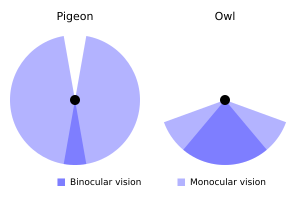Binocular vision facts for kids
Binocular vision means using both eyes together to see. It's not just having two eyes, but how your brain combines the pictures from each eye. This helps you see one clear image. Most animals with backbones and many other creatures have this type of vision.
Humans can see about 200 degrees horizontally with both eyes. About 120 degrees of this is seen by both eyes at the same time. The other parts, about 40 degrees on each side, are seen by only one eye.
Our vision system uses something called parallax to figure out how far away things are. Parallax means that because your eyes are in slightly different spots, they see things from slightly different angles. Your brain uses these small differences to create a strong sense of depth. This feeling of depth is called stereopsis. Even though each eye sees a slightly different picture, your brain usually combines them into one single image. This is called binocular fusion.
Stereopsis is the feeling of depth you get when you look at something with both eyes. Because your eyes are in different places on your head, they get two slightly different views of the same scene. Your brain then uses these small differences to work out how far away objects are.
How Eyes See the World
Field of View and Eye Movements
Some animals have their eyes on the sides of their heads. This gives them a very wide field of view. It helps them see danger coming from almost any direction. Animals like rabbits, buffaloes, and antelopes are good examples. Their eyes often move separately to cover even more area. Some birds can even see all around them, a full 360 degrees, without moving their heads!
Other animals, especially those that hunt, have their eyes at the front of their heads. This means they don't have as wide a view, but it's great for binocular vision and stereopsis. This helps them judge distances very well, which is important for catching prey. Humans, eagles, wolves, and snakes are examples of animals with forward-facing eyes.
Not all predators have forward-facing eyes. Large animals like sperm whales and killer whales have eyes on the sides of their heads. Also, some animals that aren't predators, like fruit bats and many primates, have forward-facing eyes. These animals need to see depth well to do things like pick a specific fruit or grab a certain branch.
In animals with forward-facing eyes, their eyes usually move together. But some animals use both strategies. A starling, for example, has eyes on the sides for a wide view. But it can also move them forward so they overlap, giving it stereopsis. A chameleon is a very interesting example. Its eyes can move completely on their own, up or down, left or right. But when a chameleon is hunting, it can bring both eyes to focus on one object to get that important depth perception.
Images for kids
See also
 In Spanish: Visión binocular para niños
In Spanish: Visión binocular para niños





